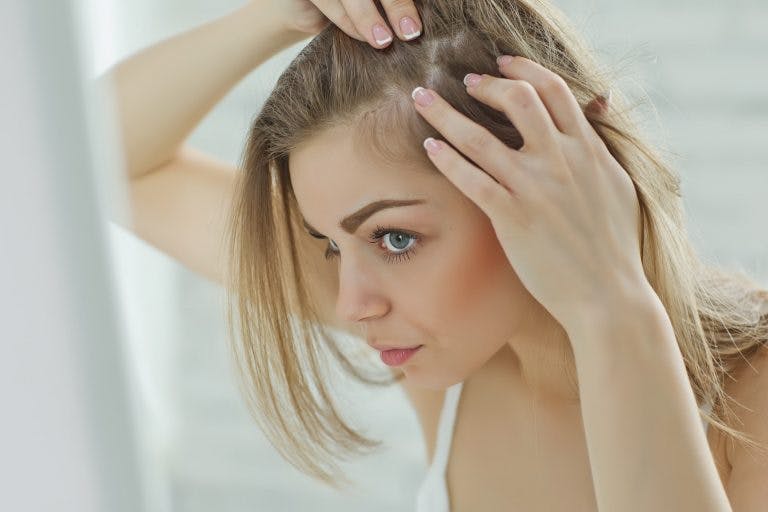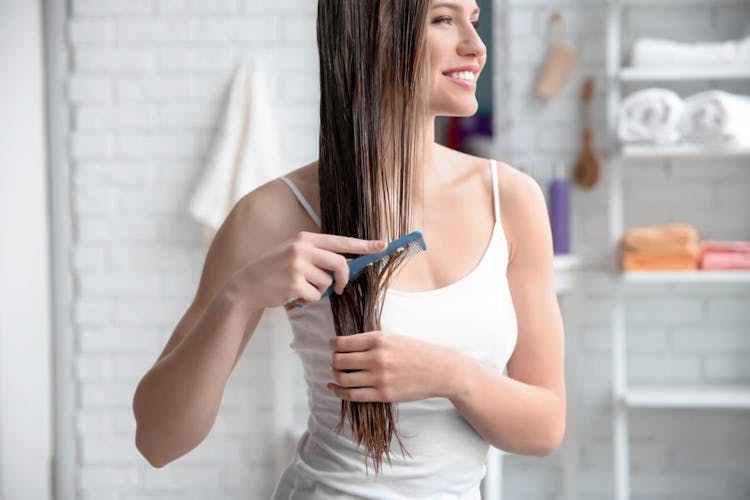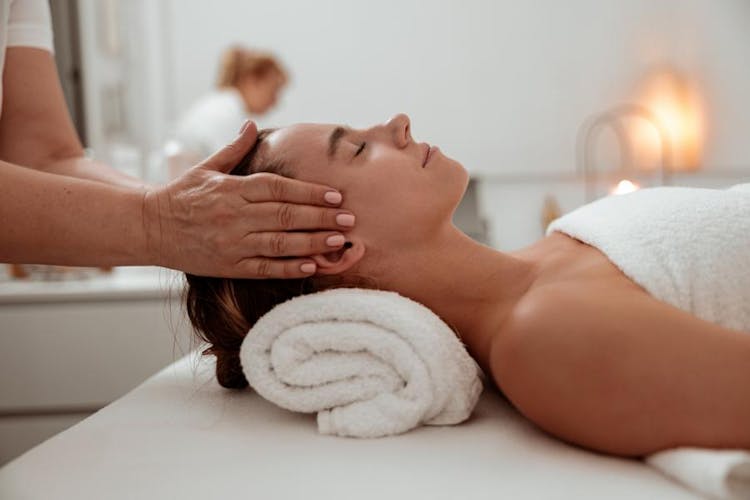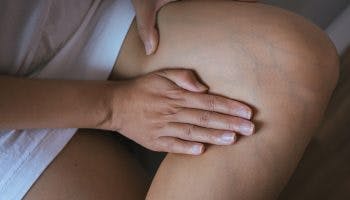Hair Loss in Women: Common Causes and 5 Ways to Treat It
Published | 6 min read
Hair loss in women is common and treatable! Check out our list of common causes and how to naturally treat your hair using TCM practices.

Did you know that 30 million American women experience hair loss, also known as alopecia? While hair loss or baldness in men is common, we all experience some form of hair loss every day. In fact, we generally shed between 50-100 strands of hair. However, issues arise when more hair falls out than it actually grows back.
A person’s hair typically goes through three cycles: anagen, catagen, and telogen. The anagen phase (growth phase) spans over 2-6 years. It’s responsible for the growth of 85-90% of the hair on the head. The catagen phase (transition phase) usually lasts for 2-3 weeks and involves shrinking hair follicles. The telogen phase (resting phase), on the other hand, will last for 2-4 months and involves hair fall.
Here are the causes of hair loss in women and some steps you can take to treat this condition.
Common Causes of Hair Loss in Women

The most common type of hair loss in women is female-pattern hair loss. This can affect anyone. However, this type of hair loss is generally seen in women over 40 or women undergoing chemo. It can also happen after giving birth, as a result of menopause, or from chemicals used on the hair. Below, you’ll find more about these common causes.
Androgenetic alopecia (female-pattern hair loss)
This type of hair loss is common among older and post-menopausal women. In fact, there are 3 characteristics of androgenetic alopecia in women — type 1, 2, and 3 hair loss. Type 1 causes minimal thinning that one can hide with different hairstyles.
Type 2 is a decrease of hair volume and visibly wider mid-line hair parting. While type 3 indicates diffuse thinning, which is signified by a see-through appearance on the top of the scalp.
Alopecia areata
Alopecia areata is a medical condition that causes the immune system to attack healthy tissues like hair follicles. Because of this, a person’s hair will start to fall out and stunt new hair growth.
In some cases, alopecia areata can also cause a person’s eyebrows and eyelashes to fall out. If left untreated, this condition can lead to alopecia totalis, which refers to a complete loss of hair.
Traction alopecia
Styling hair a particular way, including wearing tight ponytails, braids, and harsh brushing can pull hair away from the scalp. This causes hair strands to become damaged and fall out. Particular hair styling leads to thin hair and bald spots. Additionally, hair chemicals and dyes can contribute to this type of hair loss.
Telogen effluvium
This condition usually develops after a medical event or condition like pregnancy, surgery, acute or chronic illness (especially if there is fever), or a thyroid imbalance. Telogen effluvium occurs when many hair follicles enter the telogen phase of the hair cycle but don’t progress to a new anagen phase.
Extreme dieting, such as anorexia, can cause hair loss. This also relates to vitamin or mineral deficiency, the use of certain medications, or the starting and stopping of oral contraceptives. But unlike alopecia areata, telogen effluvium will not cause baldness. Still, it can result in a person losing 300-500 strands of hair every day and makes the hair look thin at the crown and temples.
Other hair loss causes
Hair loss can also be related to a pre-existing condition such as lupus, thyroid disease, cancer, and cancer treatments. Certain prescription medications, rough hair pulling, and hormonal balances can also be the culprit.
How to Treat and Prevent Hair Loss in Women

To determine the right treatment option, a dermatologist will conduct several tests to understand your pattern of hair loss. This includes a gentle pull of the hair, scalp biopsy or examination, and blood tests. They may decide on the use of medications, changing your diet, or a hair transplant surgery.
Alternatively, Traditional Chinese medicine (TCM) practitioners believe that a person’s hair (or lack thereof) reflects their overall health. An example of this notion is that a lack of blood in the body is the primary cause of hair loss. Given that the liver and spleen govern blood, TCM states that hair loss is associated with problems in these organs.
1. Apply a cream
The use of a topical solution like minoxidil (brand name Rogaine) can help stop thinning and stimulate hair growth in women. Consistent, direct application of a minoxidil solution 2% onto the scalp over 2-12 months is ideal for encouraging the growth of fine hairs. However, it can cause irritation and dryness to the scalp. Ask your doctor for guidance on whether this topical cream is right for you.
2. Get a scalp massage or acupuncture treatment
According to a study, massage can improve hair thickness. This same study also suggested that healthy hair growth could be attributed to an improvement of scalp blood flow and direct stimulation of dermal papilla. These are the layers of skin in which hair follicles and sweat glands reside.
Similarly, acupuncture can reduce inflammation of hair follicles and promote positive blood flow. The study also noted that acupuncture can improve local microcirculation, make the body full of qi (vital energy), then promote growth. This was particularly seen in patients with alopecia.
3. Consume healthy foods
For hair loss treatment and prevention, limiting your consumption of cold, fried, oily, and sweet foods can maintain the health of your spleen, which supports blood production. Consume more grains, legumes, nuts, and seeds, as well as fruits and vegetables. It is also important to add foods rich in iron and protein such as lean meats and fish to your diet. Research on mice shows that vitamin D3 is important for our hair follicle cycle. However, further studies need to be conducted on humans to determine the impact of vitamin D3 on the hair.
Consequently, consuming a herbal beverage that combines ingredients like goji berries, longan, and red dates can have a nourishing effect on your blood. You may also choose to mix a powdered formula that includes black sesame seeds and black beans with soy milk or oatmeal to prevent hair fall. Additionally, taking a natural hair formula supplement with fleeceflower root can stimulate hair growth, help support the functions of the liver and kidney, boost circulation, and cool the blood. Thus, making your hair grow faster, thicker, and stronger.
4. Limit your stress
Stress can’t cause hair loss altogether, but it can trigger it or make this condition worse. In addition, remember to exercise, get enough sleep, and practice deep breathing exercises to help you stay calm. The good news is stress related to hair loss isn’t permanent. Practice these methods every day to reduce loss and for your overall well-being.
5. Be gentle to your hair
Many women love to follow the latest hairstyles and trends. This might have them wearing various colors and styles using chemicals or tugging at the hair. If you notice that your hair starts to fall more excessively, it’s best to ease up on any extreme styling. Coupled with a regular head massage can aid in regrowth.
Hair loss in women not only impacts how you look, but it can severely affect your confidence and self-esteem. Following these easy tips can help you achieve thicker, more lustrous hair. Lastly, consuming TCM herbs can also help you to have healthy hair by taking care of your organs.
References
- American Academy of Dermatology. 2021. Skin Conditions by the Numbers. [Accessed on December 21, 2021]
- Cleveland Clinic. 2021. Hair Loss in Women. [Accessed on December 21, 2021]
- Eplasty. 2016. Standardized Scalp Massage Results in Increased Hair Thickness by Inducing Stretching Forces to Dermal Papilla Cells in the Subcutaneous Tissue. [Accessed on December 21, 2021]
- Mayo Clinic. 2021. Stress management. [Accessed on December 21, 2021]
- Dermatol Online. 2010. Does D matter? The role of vitamin D in hair disorders and hair follicle cycling. [Accessed on December 21, 2021]
- Baltimore Medicine. 2020. A randomized controlled clinical study of acupuncture therapy for Seborrheic alopecia in young and middle ages. [Accessed on January 12, 2021]
- Medical Acupuncture. 2016. How Do You Treat Premature Hair Loss in Women in Your Practice. [Accessed on January 12, 2021]
Share this article on






